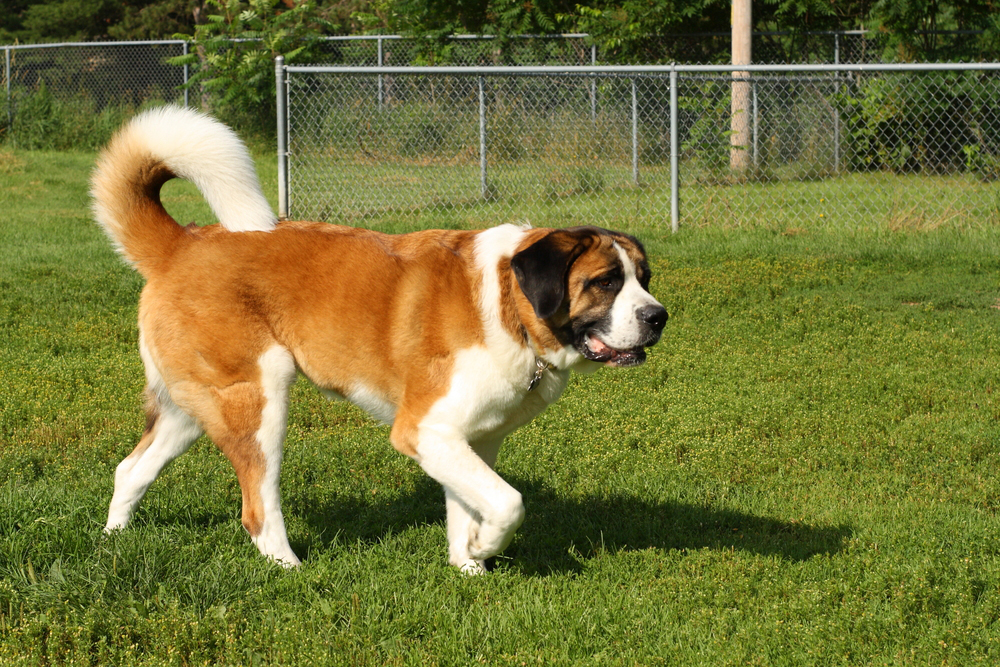Considered a giant breed of dog, St. Bernards can’t be overlooked. Since the early days of the Beethoven movies, St. Bernards have been a fan favorite. Originating in the Alps, St. Bernards were bred to be strong and hearty to aid in human rescues in the treacherous mountains. If you are considering adding a St. Bernard to your home, continue reading to learn more about common health issues affecting the breed.
The 9 St. Bernard Health Issues
1. Hip and Elbow Dysplasia
Large breed dogs like St. Bernards are more likely to have elbow and hip dysplasia. In cases of joint dysplasia, the bones forming the joint are abnormal, leading to unusual conformation. Incorrect joint formation leads to laxity which causes unusual wear and tear. Arthritis develops and lameness is often observed.
In some cases, patients do not show signs of discomfort until later in life; however, there is often orthopedic evidence of poor conformation on radiographs. In severe cases, surgery may be needed to correct the joint; in others, supportive care may be all that is necessary. Supportive care may include joint supplements, regular exercise, and pain medication.

2. Osteosarcoma
Osteosarcoma is a malignant cancer of the bones. Large breed dogs tend to be more often impacted, making the St. Bernard predisposed. Bones of the limbs, the jaw, and the spinal column are often sites of osteosarcoma development. There is a high chance of metastasis, with the lungs being a common site of occurrence. This is a very painful condition, and depending on the location of the cancer, amputation of the affected limb or radiation may be recommended.
3. Arthritis
Joint discomfort that is the result of chronic inflammation, irritation, and aging is referred to as arthritis. Large breed dogs put more strain on their limbs than smaller breed counterparts. There are several different causes of arthritis ranging from dysplasia to previous surgeries. Arthritis can cause severe discomfort in patients. Supportive care for an arthritic dog can include joint supplements and pain management.

4. Bloat
Bloat is a serious condition that occurs most often in large-breed, deep-chested dogs. A study by Purdue suggested that the St. Bernard was the second most likely breed to develop bloat. In bloat, the stomach becomes dilated and sometimes flips on itself leading to vascular compromise.
When this occurs, bloat is then referred to as gastric dilatation and volvulus, or GDV. This is a life-threatening situation that requires surgical intervention. Preventative measures can be taken to minimize the chances of bloating, including gastropexy, or the adhering of the stomach to the abdominal wall to prevent torsion.
5. Dilated Cardiomyopathy
Dilated Cardiomyopathy, or DCM, is a heart condition in which the musculature of the heart experiences degeneration. As this occurs, the heart’s musculature becomes weakened. As a result of weakened musculature, pumping blood becomes less efficient and can cause the heart to progress into heart failure.
DCM is life-threatening. Fortunately, there are ways to support dogs with this condition. Your veterinarian may recommend a consultation with a cardiologist to develop a plan for ongoing monitoring and interventions. DCM is the leading cause of heart failure in several large breed dogs, including the St. Bernard.
PangoVet. It’s an online service where you can <b>talk to a vet online</b> and get the personalized advice you need for your pet — all at an affordable price!</p>
<p><div class="su-button-center"><a href=https://www.dogster.com/ask-the-vet/"https://pangovet.com/?utm_source=dogster&utm_medium=article&utm_campaign=dog_infection_illness%22 class="su-button su-button-style-default" style="color:#FFFFFF;background-color:#FF6600;border-color:#cc5200;border-radius:9px;-moz-border-radius:9px;-webkit-border-radius:9px" target="_blank" rel="nofollow"><span style="color:#FFFFFF;padding:0px 24px;font-size:18px;line-height:36px;border-color:#ff944d;border-radius:9px;-moz-border-radius:9px;-webkit-border-radius:9px;text-shadow:none;-moz-text-shadow:none;-webkit-text-shadow:none"> Click to Speak With a Vet</span></a></div></div></div></p>"}" data-sheets-userformat="{"2":513,"3":{"1":0},"12":0}"> If you need to speak with a vet but can’t get to one, head over to PangoVet. It’s an online service where you can talk to a vet online and get the personalized advice you need for your pet — all at an affordable price!
6. Entropion
Dogs with loose skin around the eyes, like the St. Bernard, are more likely to have entropion, a condition in which the upper or lower eyelids turn inwards towards the eye. This can cause irritation of the eye itself. As the eyelashes irritate the cornea, secondary corneal ulcers may occur. Surgery can be done to correct this condition.
7. Lymphoma
Lymphoma is a common cancer that tends to impact St. Bernards more frequently than other breeds. This cancer impacts the lymph nodes and the lymph system. There are several different forms of lymphoma, some of which impact internal organ systems. Dogs diagnosed with lymphoma may be referred to oncologists. Chemotherapy is the treatment option of choice in most patients.

8. Wobblers
Dogs suffering from Wobbler syndrome may face a variety of clinical signs including cervical pain, muscle atrophy of hindlimbs, and an unsteady gait. The exact cause of Wobbler disease is not understood currently but most dogs with this condition have spinal cord compression.
9. Addison’s Disease
Hypoadrenocorticism, or Addison’s disease, is an endocrinopathy hallmarked by low cortisol levels and abnormal electrolytes. Patients with Addison’s disease may first be diagnosed with this disorder while undergoing stress, leading to shock. Fortunately, if quick intervention is done for dogs experiencing shock, recovery is possible. Dogs with Addison’s disease can live long lives with appropriate supplementation of steroids and mineralocorticoids.

In Summary
St. Bernards are a show-stopping breed due to their size and gentle demeanors. They make excellent household companions. As with any breed, St. Bernards may be predisposed to certain illnesses. Ensuring that your companion comes from a reputable breeder who has done extensive breed testing will help minimize the chances of some unwanted characteristics that may lead to disease.
Featured Image Credit: Zoran Photographer, Shutterstock












